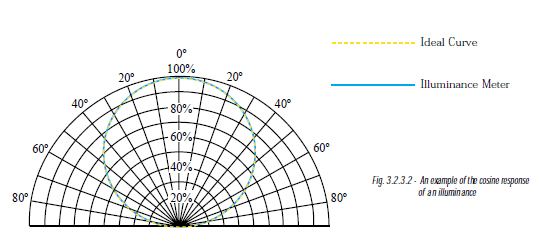Language of Light
3.Instrumentation
3.2 PHOTOMETER
3.2.3.2 ILLUMINANCE METER
Illuminance is a measure of visible energy falling upon an object’s surface. Illuminance measurements are particularly susceptible to errors caused by off-axis light. By definition, light at the measurement plane should be proportional to the cosine of the angle at which the light is incident. However, due to total integration of the sensor into the detector head or the illuminance meter itself, many illuminance meters do not naturally collect light correctly according to the cosine law.
Cosine correction feature is included in the illuminance meter by means of a cosine diffuser which is placed over the sensor and filter. It is important to note that different systems will generate different cosine responses which result in different cosine errors at different incident angles due to the nature of the system geometry.
Therefore, it is important to understand the system cosine response when comparing illuminance measurements from different illuminance meters, especially when off-axis light measurement is concerned.

Illuminance measurement is widely used in ambient lighting measurement to determine how well the room is lighted up for ease of reading or working. For example, a comfortably lit desk should be illuminated at 300 lx.
Illuminance meter is sometime used to compute measurement in term of ANSI lumen (especially in projection system measurement), by simply averaging the nine points illuminance measurement in lux and multiply by the measurement area in square meter encompassed by the nine points measurement.

